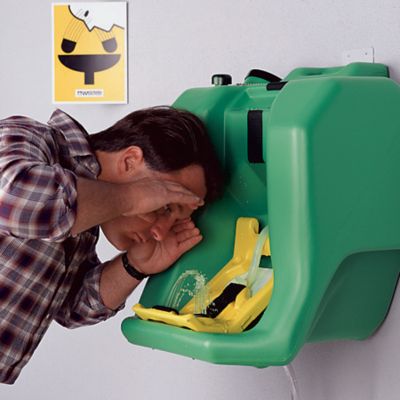The ninth carrier of the morning reverses up to the receiving dock. His truck sports the familiar black and white, Class 8 “Corrosives” placard. Wheel

Corrosives are so commonly used in industry that, like many hazardous materials, they often aren’t given much thought. Knowing their properties helps ensure that they are handled and stored safely, minimising the potential for harm to personnel and the environment.
The Scale
The activity, or “power,” of hydrogen ions in a solution is what is commonly referred to as pH. The pH of a liquid is gauged on a scale of 1 to 14, with a pH of 1 being very acidic, 7 being neutral and 14 being very caustic.
It is not uncommon for car parks, loading bays and drive-through areas to be stained with small amounts of oil that have dripped from vehicles. When it rains or when snow melts, water carries this oil to storm drains.
It is important to look at all of the characteristics of a material when making a hazard determination and creating safety plans. For example, carbonated colas typically have a pH of 2.5. But a peroxide solution with a pH closer to neutral, is likely to cause greater damage if it is not stored and handled properly.
Everyday Use
Batteries, bleach, and even fruit juices are examples of corrosive materials commonly found in homes, and often without incident. In commercial and industrial facilities, two examples of corrosive materials are etching solutions and water treatment chemicals. Listed below are more corrosives and their everyday uses.
| Common Acids | Common Uses |
| Hydrochloric Acid Phosphoric Acid Sulfuric Acid |
Water treatment, etching, metal cleaning Rust-proofing metals, soft drink manufacturing Batteries, electroplating |
| Common Bases | Common Uses |
| Sodium Bicarbonate Sodium Hydroxide Sodium Hypochlorite |
Fire extinguishers, antacids, pharmaceuticals Water treatment, etching and electroplating Disinfecting, water purification |
Safety
Knowing the properties of a solution, including the pH, helps determine what precautions will be necessary to protect employees from harm. This goes beyond gloves and goggles, however — safety training should include proper storage and handling as well as emergency response procedures and proper disposal of spent materials.
Information about the proper personal protective equipment (PPE) and handling of a liquid can be found on the Safety Data Sheet (SDS). Other resources are the chemical manufacturer and safety suppliers.
Storage
Proper storage involves not only checking containers to make sure there aren’t any leaks, but also making sure that they are not placed in areas where they could come in contact with other chemicals that will cause an adverse reaction.
Although most facilities don’t have the luxury of unlimited storage space, “making room” to store incompatible materials in separate areas can help avoid problems later. Training material handling personnel on why it is important to take the time to put materials in designated areas will also help ensure safety.
Spill containment pallets are another option to aid in storage. In the event of a leak while containers are in storage, the spill will be contained in the sump of the pallet, avoiding slip and fall hazards, costly fines if the material enters a drain, and possible chemical reactions with other materials in the area.
Handling
Transferring corrosive materials for use in various processes is a common cause of injury and spills. During transfer, fittings sometimes come loose, and hand pumps are notorious for consistent small drips.
Storing eyewash stations can also provide quick help for employees who may become injured by corrosives.
Battery recharging stations are another common area where corrosive liquids are handled. Stocking PPE, having a drench shower and stocking spill response materials in this area will also help increase safety.
Double Checking
When hazardous materials are handled on a daily basis, it is sometimes easy to forget their hazards. Revisiting safety guidelines and double checking storage and handling procedures can help ensure that everyone stays safe.
Find out more:
New Pig offers a comprehensive range of products for the storage and handling of hazardous materials at our online shop www.newpig.co.uk. Or why not give us a call on 0800 919 900.






COMMENTS